Before getting into the best streaming devices to buy in 2022, let me make a proper introduction first. Cable TV is dead as disco—we’ve known it for some time now. It’s all about streaming these days. I mean, I can’t remember the last time I intentionally turned on a TV to watch something.
But obviously, this doesn’t apply to everyone and I totally get that. Regardless, if you want to binge the new season of “The Witcher” on Netflix, “The Book of Boba Fett” on Disney+ Hotstar, “The Boys” on Prime Video, and so on and so forth on your TV, then you’ve got two options.
Either buy a relatively expensive smart TV that supports all those OTT platforms or get a streaming device that can even turn a basic television smart by connecting to an HDMI source. And that’s exactly what I’ll be talking about today. Not smart TVs but some of the best streaming devices you can buy in 2022.
Best Streaming Devices In 2022
For this list of the best streaming devices in 2022, I’ve been testing out a few popular TV sticks you can buy right now—all under USD 50 or roughly NPR 10,000 here in Nepal. So you won’t find high-end streaming devices like the Apple TV 4K, NVIDIA Shield TV, or Amazon Fire TV Cube here. On top of this, I would’ve liked to get my hands on the Roku Streaming Stick 4K as well—but couldn’t find it.1. Chromecast with Google TV
So, the first one on my list is the Chromecast with Google TV—which is also my favorite one of the bunch. It’s not perfect—no—but for someone like me who uses an Android phone and doesn’t own any Alexa device, Chromecast does it all.
Powered by Arm’s quad-core Cortex-A55 CPU alongside 2GB RAM and 8GB of internal storage, it runs pretty damn smooth. For an even snappier UI response, you can also enable developer options and reduce animation scale.
Anyway, as the name implies, this thing runs on Google TV, which is an upgraded version of the Android TV interface that’s popular on most smart TVs. Its enhanced UI/UX with the material design that’s complemented with big icons, makes browsing through the TV a thoroughly refreshing experience.
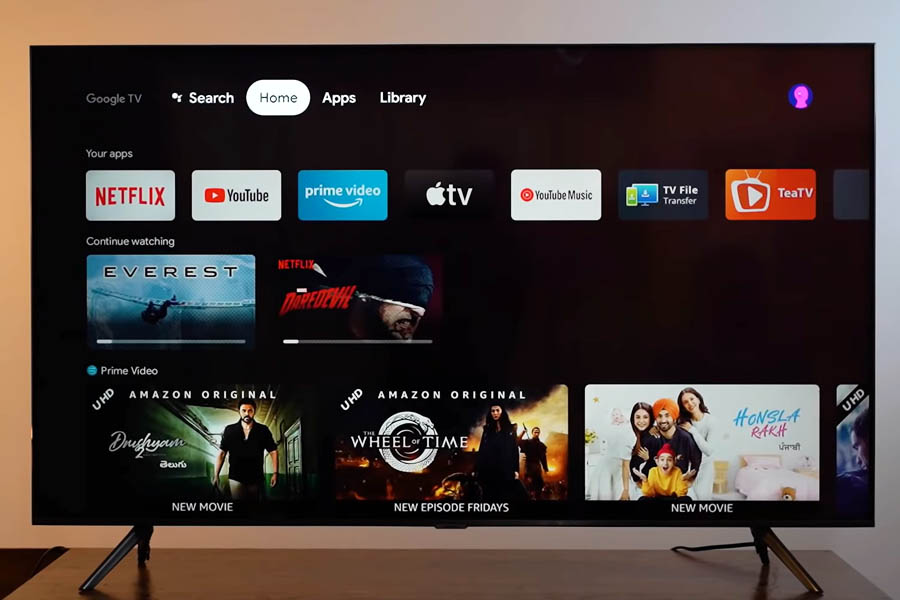
But maybe it’s geoblocked or something—the Chromecast didn’t share the same visual layout as depicted in the official product page in my case.
How's the UI?
The “For You” tab, for instance, is called “Home” here. And there’s no separate tab for “Movies” and “Shows” either. Things are a lot more simplified with the “App” and “Library” sections instead. Regardless, the aforementioned “Home” section is where you’d be spending most of the time with the Chromecast. It hosts a rearrangeable list of your installed apps, followed by the “Continue Watching” section.
Weirdly enough, the continue watching tab only displays my Netflix history—and not from other apps like Prime Video, YouTube, and Crunchyroll. Following this are the separate tabs (or “Channels” as Google calls them) for all your installed apps. But like on the older Android TV interface, I wish I could change the hierarchy of how they appear.
In my case, Chromecast failed to show Prime Video recommendations and was instead limited to Netflix, YouTube, and Google Play Movies & TV. About the playback quality itself, it doesn’t disappoint. While there’s no support for adaptive resolution here, you can set HDR to “Always HDR” or one that matches the content type.
I watched a couple of 4K HDR-compatible videos on multiple platforms and they played like a charm—“Marvel’s Daredevil” on Netflix and “The Wheel of Time” on Prime Video, to name a few. It can play compatible Dolby Vision/Dolby Atmos contents without breaking a sweat as well.
Up to 12-bit colors
For even superior colors, Chromecast also supports up to 12-bit colors. Then again, your TV should be 12-bit compatible as well. Besides streaming content, you can also search web results, download your favorite apps from the Play Store, add shows/movies on your watchlist, or cast content from your phone, laptop, and other devices to the TV.
At times, however, Google Assistant couldn’t process my voice commands properly—especially the final words of the sentence. Weird.
Furthermore, Chromecast lets you add a separate user profile for your kids too. Under this, you can set the TV viewing schedule, restrict app access, and even set content rating limits for your children. Yet, storage could be big trouble in the long run since after just installing a couple of apps and setting up a Kids profile, I’m left with roughly 750MB of free space out of the 4.4GB available.
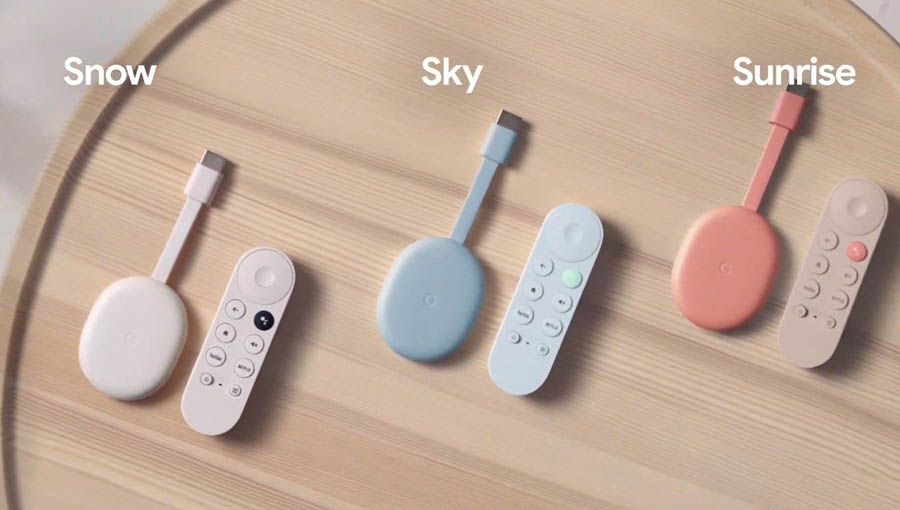
Let’s briefly go over its design now. Because the Chromecast doesn’t have a traditional stick-shaped design, it slots in non-intrusively on most TVs.
That’s why Google doesn’t ship an HDMI extender inside the box. And its remote is something to admire as well. From its ergonomic design to the soft-feedback buttons, this is one of the best TV remotes out there. Plus, it even has a dedicated button to switch between input devices connected to the TV.
Chromecast with Google TV Specifications:
- Body: 162 x 61 x 12.5mm, 55 gm
- Power: USB Type-C
- Processor: Amlogic S905D3
- CPU: 4x Cortex-A55 (1.9GHz)
- GPU: Arm Mali-G31 MP2
- Memory: 2GB RAM, 8GB storage
- Display: Up to 4K Ultra HD @60fps
- HDR: Yes (HDR10, HDR10+, Dolby Vision)
- Audio: Dolby Digital, Dolby Digital Plus, Dolby Atmos
- Connectivity: WiFi 5 (802.11 ac, dual-band), Bluetooth 4.2
- Ports: HDMI (to plug directly into the TV)
- OS: Android TV OS (with Google TV on top)
- Remote: 122 x 38 x 18mm, 63 gm
- Mic: Integrated microphone for Google Assistant
- Color Options: Snow, Sunrise, Sky
- What's In the Box: Chromecast, Power cable, Power adapter, Voice remote, 2x AAA batteries
- Price in Nepal: Rs. 10,500
2. Amazon Fire TV Stick 4K
Next up in our list of best streaming devices in 2022, we have the Amazon Fire TV Stick 4K. Before getting to the nitty-gritty details, you need to know that there’s a newer version of this streaming stick called the Fire TV Stick 4K Max. It’s USD 5 more expensive, but for the added cost, brings a whole lot of value.
From faster performance, WiFi 6 support, to all the more buttons on the remote, the “Max” edition is well worth the extra money.
That’s not to say the regular Fire TV Stick 4K is any slouch. In fact, among all the streaming devices I’ve tested so far—it’s the fastest. Running on a custom Fire OS platform (which is still based on Android, by the way), I haven’t faced any major performance hiccup here. Sure, there are minor lags every now and then—especially during first-boot—but that’s about it.
Oh-so-Prime
However, the way Amazon so aggressively pushes Prime Video content here is overwhelmingly frustrating. The homescreen is littered with recommendations from Prime Video across several genres, and neither can they be customized.
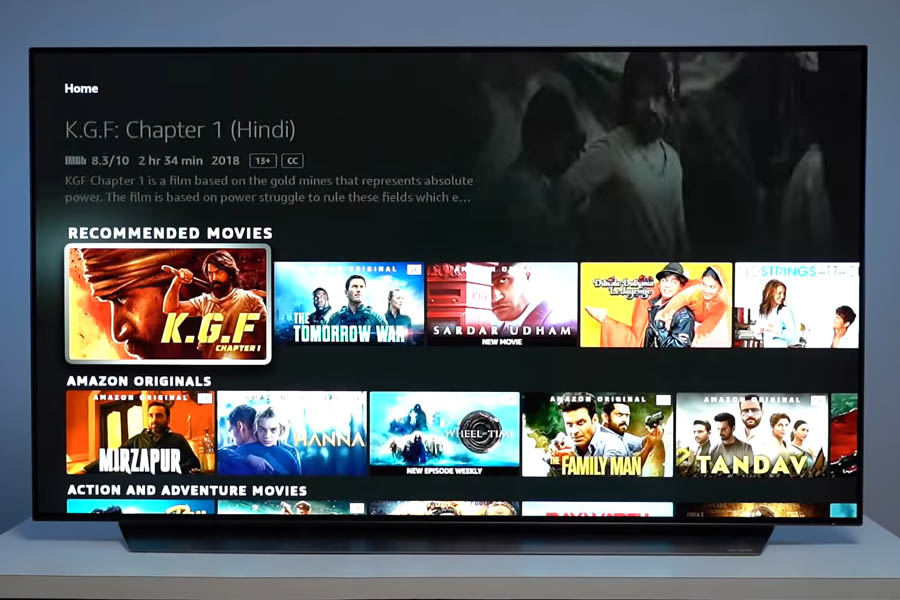
So, if you’re like me who’s mostly in the “Netflix wall”, then none of this is going to be of any use. On top of this, the Fire TV Stick 4K makes more sense if you also own Amazon Echo devices like Echo Show, Echo Dot, and such.
Besides recommendations, it even refuses to show Netflix contents inside the “Recently Watched” tab, whereas I couldn’t get Alexa to find content on Netflix either. Interestingly, logging in with a US-based Amazon account, the Fire TV Stick 4K could discover Netflix contents.
Some features are geoblocked
Looking at the official product page, it seems that the Fire TV Stick 4K can indeed search content on Netflix, Disney+, Hulu, and other streaming services—so I’m guessing this feature is just geoblocked here in Nepal. Apart from Prime Video recommendations, the homescreen also shows the list of recently used apps for quick access.
Swiping to the right, you have the “Find” page that hosts a categorical list of discoverable shows/movies, while the “Live” section is missing in this part of the world. All in all, I found Fire OS incredibly easy to get used to—and the aforementioned responsiveness makes using Fire TV Stick 4K all the more delightful.
Although Amazon Appstore’s library isn’t as vast as that of the Google Play Store, you’ll find all the streaming platforms, games, and other utility apps here. Amazon lets you install apps directly from its website as well.
Anyway, like the Chromecast with Google TV, it comes with Dolby Vision and Dolby Atmos support too. Weirdly enough, some of the Netflix shows with these two standards that played perfectly fine on Chromecast didn’t support Atmos playback on the Fire TV Stick 4K—while Prime Video didn’t face such an issue. This feels more like a Netflix issue, so I’m hoping a fix is on the way.
Dialog Enhancer
Similarly, you can set its resolution up to 4K/60Hz or keep it at auto. With a compatible TV, it can even render content in up to 12-bit colors. There’s also a “Dialog Enhancer” feature built-in, but I didn’t really notice any difference when turning it on/off. Watching Daredevil on Netflix, the Fire TV Stick 4K comfortably jumped to 4K HDR settings in a matter of seconds on our 60Mbps home internet.
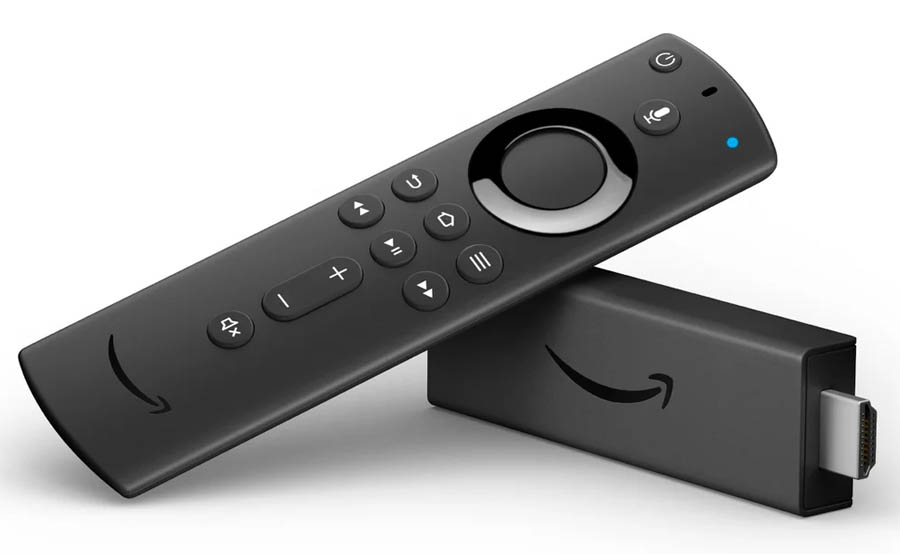
I personally didn’t encounter any issue with wireless connectivity, but if you have an Ethernet adapter lying around, hooking it up isn’t gonna do any harm. Its stick-like design could be difficult to install on some TVs, so Amazon does provide an HDMI extender inside the box. On the other hand, this plastic-made remote is equally impressive.
It’s taller than the Chromecast remote but you can easily operate it with one hand. The button feedback is pretty great and it can even control your TV volume, on top of turning it on/off. So, that’s one less reason to have the TV remote by your side at all times!
Amazon Fire TV Stick 4K Specifications:
- Body: 108 x 30 x 14mm, 53.6 gm
- Power: Micro USB
- Processor: MediaTek MT8695 + MT7668
- CPU: 4x Cortex-A53 (1.7GHz)
- GPU: PowerVR IMG GE8300
- Memory: 1.5GB RAM, 8GB storage
- Display: Up to 4K Ultra HD @60fps
- HDR: Yes (HDR10, HDR10+, HLG, Dolby Vision)
- Audio: Dolby Digital, Dolby Digital Plus, Dolby Atmos
- Connectivity: WiFi 5 (802.11 ac, dual-band), Bluetooth 5.0
- Ports: HDMI (to plug directly into the TV)
- OS: Fire OS 6 (Android 7.0 Nougat)
- Remote: Integrated microphone for Amazon Alexa
- Color Options: Black
- What's In the Box: Fire TV Stick, HDMI extender, Power cable, Power adapter, Voice remote, 2x AAA batteries
- Price in Nepal: Rs. 9,500 (unofficial)
3. Realme 4K Smart Google TV Stick
Moving on, Realme recently entered the streaming arena with its own 4K Smart Google TV Stick. And it's already managed to find a spot in our list of best streaming devices to buy in 2022. But if you have a fairly high-end TV with Dolby Vision HDR and Dolby Atmos compatibility, you should skip this altogether since it supports neither of them.
Plus, considering the deals you can get on Chromecast and Fire TV Stick 4K, Realme’s streaming stick is a tad bit too expensive as well. And compared to the other two streaming devices I’ve discussed so far, its performance leaves something to be desired as well.
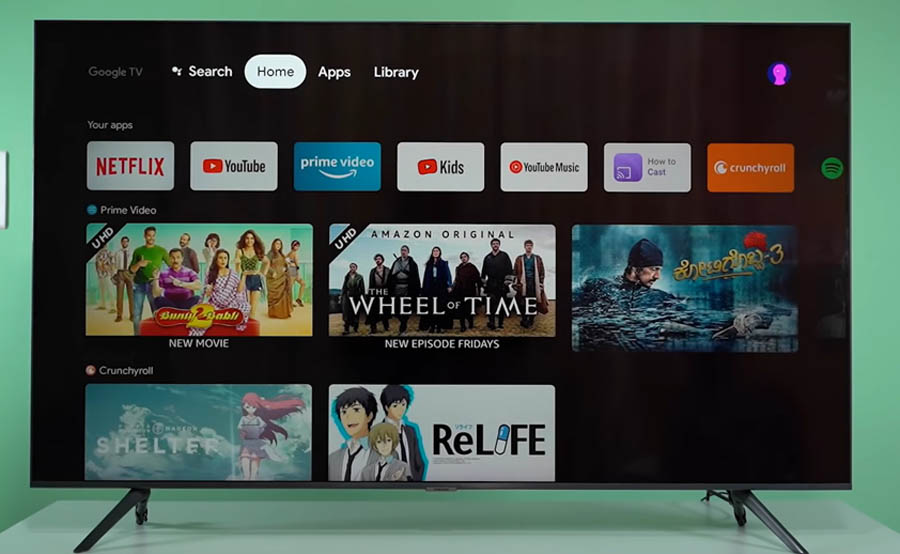
With a relatively slower quad-core processor with Cortex-A35 cores, you can notice the sluggishness every now and then on this thing. And although 2GB RAM may sound like a lot for a streaming device, this isn’t the most powerful streaming device you could find. I noticed that it even struggled to keep the homescreen in memory after playing videos on Netflix or other OTT platforms for a while.
Google TV experience
That’s not to say it’s unbearably slow—absolutely not. I know it sounds like I’m nitpicking things here, but pitting it against two of the best streaming devices available, you start to observe such things.
Running on Android TV OS 11 unlike the older Android TV 10 in our unit of the Chromecast, there’s no “Continue Watching” section here either, which is a little disappointing. Plus, it also skips a separate channel for Netflix—while every other app gets an entry in the homescreen.
Apart from this, its Google TV UI is pretty much the same as that of the Chromecast so I won’t be brushing on that topic again. This means, all the searches and recommendations are prioritized to Google’s services like YouTube—and that stuff.
Weird issues that have since been resolved
Instead, I’ll talk about the more pressing issues I’d found with this TV stick. And the biggest of them all was definitely the lacking HDR playback. I’d set all the display settings in favor of HDR playback but still nada.
Also, the volume toggles on the remote didn’t work on Netflix and Prime Video for some reason. It worked on YouTube, Spotify, and Crunchyroll as intended, but those streaming platforms were a couple of weird exceptions. Fortunately, I recently received a 729MB update that fixed both of these issues.
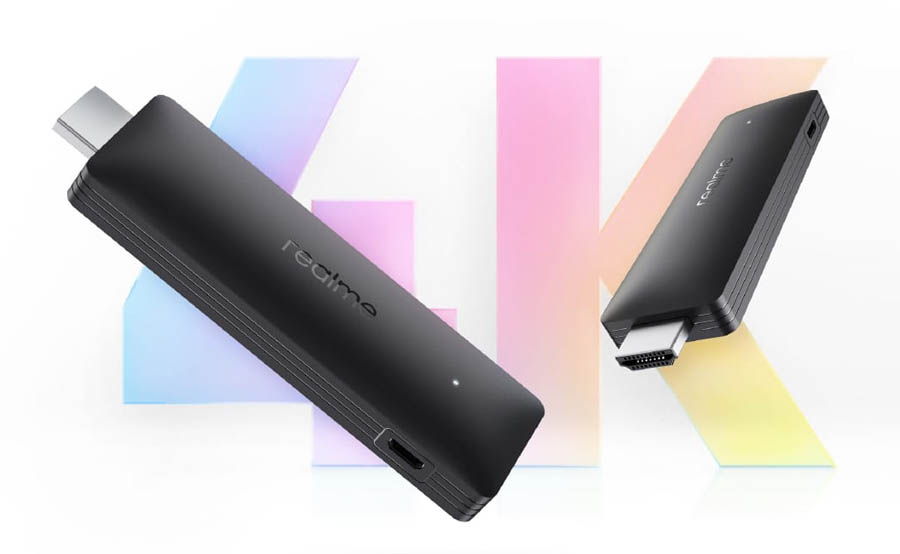
While the Realme 4K Stick initially had a single 8-bit color format option, the update brought support for up to 12-bit color depth—which eventually enabled HDR playback.
Getting to the remote, it’s pretty nice. I have no trouble with the button feedback and these dedicated buttons for different services is a great thing to have. The horizontal placement of the volume buttons is a bit strange—yes—but I got used to it pretty quickly.
Realme 4K Smart Google TV Stick Specifications:
- Body: 90 x 29.8 x 14.5mm, 30 gm
- Power: Micro USB
- Processor: 4x Cortex-A35 CPU, dual-core GPU
- Memory: 2GB RAM, 8GB storage
- Display: Up to 4K Ultra HD @60fps
- HDR: Yes (HDR10, HDR10+)
- Audio: Dolby Digital, Dolby Digital Plus
- Connectivity: WiFi, Bluetooth 5.0
- Ports: HDMI (to plug directly into the TV)
- OS: Android TV OS 11 (with Google TV on top)
- Remote: Integrated microphone for Google Assistant
- Color Options: Black
- What's In the Box: Realme TV TV Stick, HDMI extender, Power cable, Power adapter, Voice remote, 2x AAA batteries
- Price in Nepal: N/A
4. Xiaomi Mi Box 4K
The final entry in our list of best streaming devices to buy in 2022 is the Mi Box 4K, which also goes by “Mi Box S” or “Mi Box 4” depending on the market. Launched in 2020, it has a bulkier, squarish build quality which isn’t the most elegant design. Then again, its bigger form factor means Xiaomi has managed to fit in a USB-A and a 3.5mm audio jack as well.
So, if you want to stream something off of your thumbdrive and your TV’s USB-A port is occupied for some reason, then there’s no need to connect a dongle here.
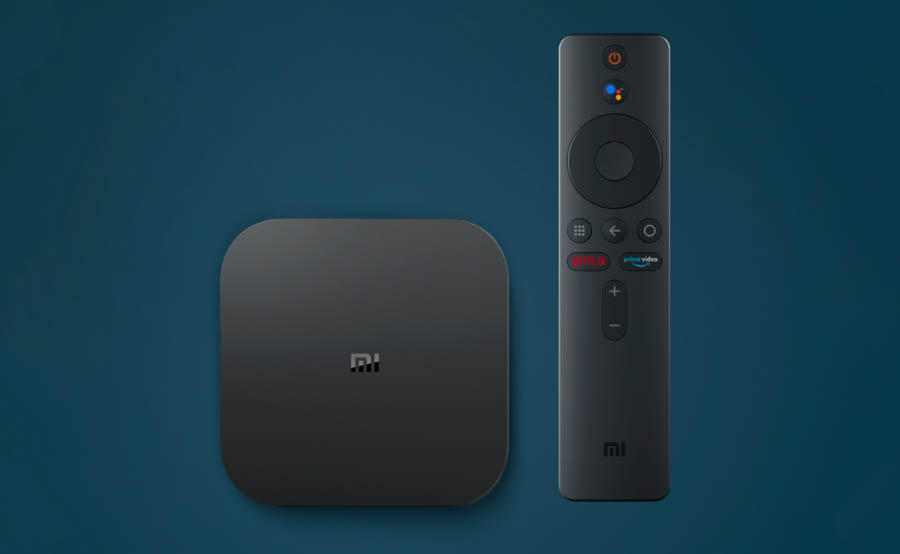
Aside from the design, the Mi Box 4K is powered by a quad-core Cortex-A53 CPU with 2GB RAM and 8GB of internal storage. However, I found its UI/UX response is the slowest of the bunch. Be it scrolling through the menus or launching apps, the minor delay here is palpable. Even voice commands take a while to process on this streaming box—which flat-out fails to deliver the desired result sometimes.
Google Assistant is a bit sluggish here
What I mean is, I’d say something like “Launch YouTube”. Then, even after I get the audio/visual prompt acknowledging my request, it doesn’t launch the said app. Another uncanny thing I noticed here was how the Netflix app failed to load completely, giving off the “ui-800-3” error code instead.
I tried every solution I could find on the web, from clearing cache to re-installing the app and such—but none of them worked.
Thankfully, the Mi Box 4K recently received an update that finally solved this issue, while also bringing July's security patch and a smoother UI/UX experience. Likewise, searching content on Netflix also works better now, but Google Assistant still can’t discover shows/movies on Prime Video.
Even though this Android TV interface looks dated compared to Google TV, I like how I can re-arrange the app channels on the homescreen. Like Realme’s TV stick, it can’t play Dolby Vision or Dolby Atmos content either. But unlike the competition, I had no trouble playing HDR videos on the Mi Box 4K.
No "SDR to HDR" option
You can also select from different color space settings, whereas the “SDR to HDR” option is absent on my unit. Unlike Xiaomi TVs, the Mi Box 4K doesn’t have Patchwall built-in although you can find its option inside the settings menu.
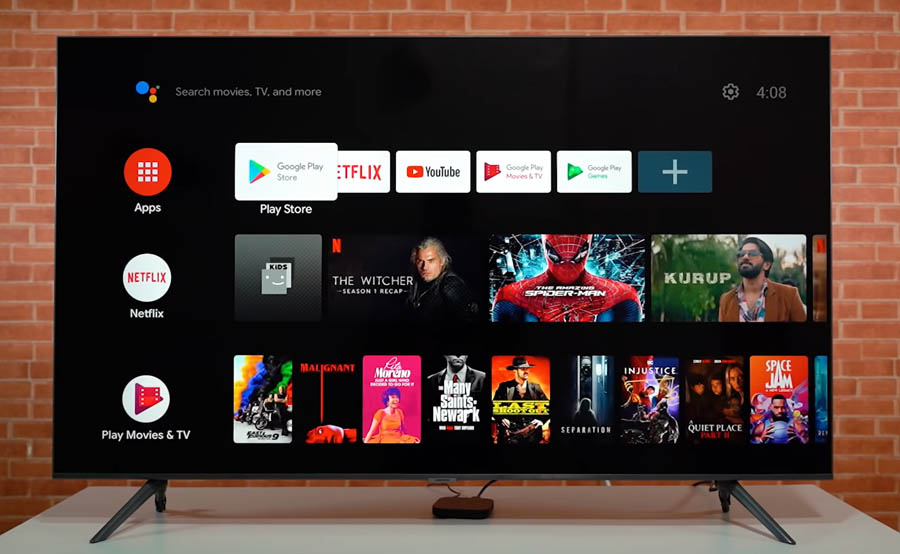
Thus, the Patchwall button on the Mi Remote is replaced by a menu button instead, that triggers your TV’s app list—alongside a few recommendations. And about this remote… I… don’t like it. The form factor is just fine but the buttons are a little too stiff, especially the circular D-pad. And Xiaomi has been greedy enough to skip the AAA batteries inside the box as well.
In related news, Xiaomi recently announced TV Stick 4K, which is the direct successor to the aging Mi TV Stick. With newer hardware and support for Dolby Vision HDR, Dolby Atmos audio, it looks like a direct competition to other popular streaming devices. As a result, even if you just own a Full HD TV or don’t care about the premium HDR standards, I wouldn’t suggest getting the older Mi TV Stick.
It is way too stuttery and lacks even the most basic HDR playback. And maybe because of this, I noticed that videos have worse black levels here. Heck, even Chromecast crashes on this sometimes.
Xiaomi Mi Box 4K Specifications:
- Body: 167 x 95.2 x 95.2mm, 148 gm
- Power: Micro USB
- Processor: Amlogic S905X
- CPU: 4x Cortex-A53 (1.5GHz)
- GPU: Arm Mali-450 (750MHz)
- Memory: 2GB RAM, 8GB storage
- Display: Up to 4K Ultra HD @60fps
- HDR: Yes (HDR10)
- Audio: Dolby Audio, DTS 2.0
- Connectivity: WiFi 5 (802.11 ac, dual-band), Bluetooth 4.2
- Ports: HDMI (to plug directly into the TV)
- OS: Android TV 9.0
- Remote: Integrated microphone for Google Assistant
- Color Options: Black
- What's In the Box: Mi Box 4K, Power cable, Power adapter, Voice remote
- Price in Nepal: Rs. 7,500 (unofficial)
Best Streaming Devices In 2022: Conclusion
So that was it for my top picks of the best streaming devices in 2022. As evident from everything I’ve discussed so far, Google’s Chromecast and the Amazon Fire TV Stick 4K are among the best options available. Brands like Xiaomi and Realme are doing pretty good in this space as well, but they’ve got a lot more refining to do.
- Watch: Best streaming devices to buy in 2022

To say something about myself, I have been writing tech and gadgets from 2021. Although coming from a non technical studies background, I'm someone who is always fascinated by the latest gadget and tech innovations, circling around. Besides writing, you'll find me listening music and aligning the stars through astrology and sometimes even, tarot cards! 😉🧿
Comments
No comments yet. Add a comment to start a discussion





